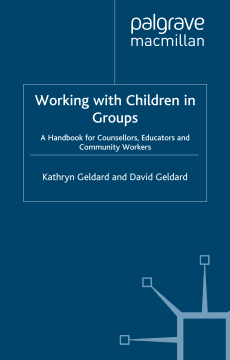
Additional Information
Book Details
Abstract
With its effective outcomes, relative speed and reduced costs, the group format is becoming increasingly popular for work with children in counselling and educational settings.
Drawing from their extensive experience of running childrens groups and training group leaders, Kathryn and David Geldard describe the entire process of running groups from the initial planning to post-group evaluation.Topics covered include the benefits and disadvantages of running groups and the types of group available, as well as the planning, designing, implementation and evaluation of group programmes.
Filled with lots of ideas, activities, games and work-sheets for use in group programmes, as well as examples of complete programmes for particular problems such as domestic violence and low self-esteem, this highly accessible and practical book will be an invaluable resource for anyone wishing to run groups for children.
KATHRYN and DAVID GELDARD are authors of Counselling Children: A Practical Introduction and Counselling Adolescents: A Pro-Active Approach (both with Sage). They work as child and family therapists in private practice, and have extensive experience in running training courses in counselling children and adolescents and working with children in groups. Kathryn lectures in the post-graduate programme at the University of Queensland, Australia. David is a Counselling Psychologist, and is the author of Basic Personal Counselling: A Training Manual for Counsellors, 3rd ed (Prentice Hall and Free Association).
Table of Contents
| Section Title | Page | Action | Price |
|---|---|---|---|
| Contents | v | ||
| List of figures and tables | viii | ||
| Introduction | ix | ||
| Part I. Groups for children | 1 | ||
| 1. Why run groups? | 3 | ||
| 2. Types of group | 12 | ||
| Part II. Planning a group programme | 27 | ||
| 3. Identifying the needs of a target group | 29 | ||
| 4. Planning to run a group | 48 | ||
| 5. Designing a group programme | 62 | ||
| Part III. Running a group programme | 77 | ||
| 6. Assessment of children for inclusion in a group programme | 79 | ||
| 7. The leader’s role | 98 | ||
| 8. Counselling and facilitation skills required inchildren’s groups | 117 | ||
| 9. Evaluating the outcomes of a group programme | 139 | ||
| Part IV. Group programmes for particular purposes | 151 | ||
| 10. Domestic violence programme | 154 | ||
| 11. ADHD programme | 168 | ||
| 12. Self-esteem programme | 180 | ||
| 13. Social skills programme | 195 | ||
| Appendix A: Activities and games | 212 | ||
| Appendix B: Work-sheets | 230 | ||
| References | 246 | ||
| Index | 255 |
